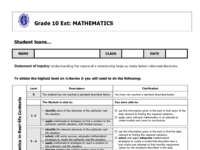Student loans
Question 1
Question 1 (continued)
According to a recent article, the typical student borrower graduating with the class of 2015 left college with an average debt of $35,051. Based on the information in the article, estimate what a typical student borrower might have had to borrow by the end of their 4-year degree course assuming they started in the same year that you would start.
Paying back what you owe
Question 2
Look at the example shown in the table below. The amount to be repaid is $20,000 with an annual interest rate of 5% and a repayment value of $377.42 per month. The Interest column is the amount of interest that is added each month. Note that interest is added to the starting balance before the payment is deducted. Note: To generate new numbers in the table, begin by dragging cell B6 down by 1 to get the next starting balance, then find the new value for the interest and then the values in the other cells. After how many months will this loan be paid off? Hint: it may be easier to recreate this spreadsheet on Google Sheets - your choice!
Check your answer to Question 2 using the website linked here.
Question 3
According to the graph you looked at previously, the average debt in 2015 for a graduating student who had borrowed money was around $35050. If this debt were to be paid off assuming a fixed interest rate of 6% per annum and a monthly repayment of $389.12, CALCULATE how long it would take. Check your result using the loan calculator.
Calculating the repayment amount
Question 4
Consider the following scenario: I borrow $500 at a fixed interest rate of 12% per annum and wish to repay the loan over a single year. If the monthly repayment amount is "x", EXPLAIN why the expression below represents the balance of the loan at the end of the first month.
Question 5
Find similar expressions for the outstanding debt at the end of months 2, 3, 4 and 5. Simplify your expressions!
Question 6
By consider the expressions you have found so far, i. explain what is happening to the initial value of $500 as the number of months increases. ii. by how much will the initial $500 grow to at the end of the 12 months? iii. describe the series that is generated by the monthly repayment "x". iv. calculate the value of the monthly repayment. v. check your result using the loan calculator above.
Question 7
In Question 1 you estimated the average debt in your year of graduation for a student who had borrowed money for their college education. Show how to calculate the monthly repayment for this debt assuming a fixed interest rate of 5% and a loan period of; i. 10 years ii. 15 years iii. 20 years.
Question 8
For the academic year 2015-16, the tuition fee at Yale was $47 600. The year you graduate from school you take a 3-year course at Yale and need to take out a loan to cover 60% of the tuition fees over the duration of the course. If you pay back the cost of your tuition over a 20 year period, with fees adjusted for inflation, with a fixed interest rate of 4.5%, how much will you pay per month?
This is the assessment rubric
Question 9
Finally, having looked at some of the maths behind how loans work and some of the potential costs involved, please consider the following question which is related to the Global Context of Fairness and development. Is access to a higher education fair or not given the increasing financial demands on students...and is it worth it?

